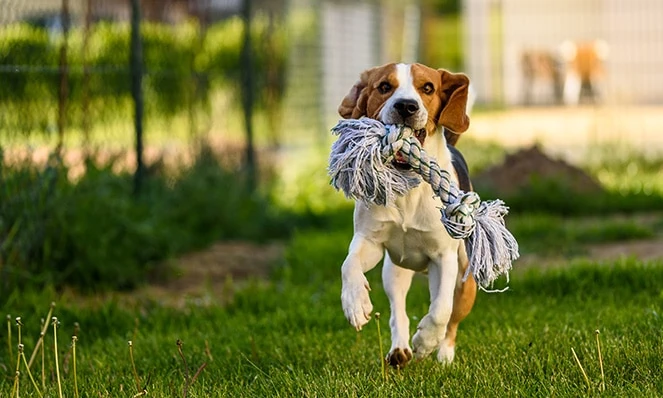Diabetes is a metabolic disorder that affects the body’s ability to regulate blood sugar (glucose) levels, resulting in the level of glucose in the blood being too high or too low. Glucose is a crucial source of energy for cells and tissues in the body, and its levels are normally tightly controlled by the hormone insulin, which is produced in the pancreas.
Obesity can cause the body’s cells to become more resistant to insulin, which would then increase the risk of developing diabetes. So, a balanced diet and plenty of exercise can help stop your pet from getting diabetes.
Diabetes results in:
- the cells in the body being unable to take up enough glucose from the blood stream
- excess glucose accumulating in the blood leading to 'hyperglycaemia'.
Diabetes is seen in dogs of all ages, sexes and breeds; however, it most commonly occurs in older dogs, with females more commonly affected.
Types of diabetes in dogs
With diabetes in dogs, there are two primary types:
Type 1 Diabetes (Insulin-Dependent Diabetes)
This type occurs when the pancreas fails to produce enough insulin or stops producing it altogether. Without the right amount of insulin, the dog's cells cannot absorb glucose effectively, leading to high blood sugar levels. Type 1 diabetes is the most common form of diabetes in dogs.
Type 2 Diabetes (Non-Insulin-Dependent Diabetes)
In this type, the pancreas may produce insulin, but the dog's cells become resistant to insulin’s effects, meaning they don't respond properly to its signals to absorb glucose. This results in high blood sugar levels. Type 2 diabetes is less common in dogs than Type 1.
What are the symptoms of diabetes?
One of the normal functions of the kidneys stops glucose being lost through urine (in healthy dogs, there should be none), however this ability is overwhelmed when the blood contains a very high amount of glucose. Your dog must drink more water as a result of the kidneys producing more urine due to this. Your dog will also require additional food to make up for the glucose it is losing because it cannot use it. They will lose weight if this is insufficient.
Signs to look out for:
- Increased urination
- Inappropriately urinating in the house
- Unsettled due to an increased frequency of urination
- Increased thirst and water consumption
- Weight loss
- Increased appetite accompanying the weight loss
- Reduced energy
- Reduced or loss of vision due to diabetic cataract formation
- In advanced cases the dog may be very unwell due to the progression of diabetes to a condition known as ketoacidosis.
Are you noticing any of the signs above? Book an appointment for a health check for your dog.
How is diabetes in dogs diagnosis confirmed?
Since some of the symptoms of diabetes in dogs are similar to those of other diseases, your vet will recommend certain blood and urine tests to make a diagnosis. Occasionally, conditions like Cushing's Syndrome and other illnesses like diabetes coexist.
For peace of mind, contact us today.
Treatments for diabetes in dogs
Diabetes in dogs is typically irreversible. Once we have a diagnosis, we will guide, teach and support you in the home management of diabetes. but y Your dog can live a normal, happy life if a routine is established, and an insulin preparation is used. Our goals would be to improve your dog's quality of life, lessen the long-term harm that diabetes does to other body parts, and halt the symptoms that make life tough at home.
Treatments and advice available from Brentknoll Vets in Worcestershire
Insulin injections
Diabetes in dogs can be effectively controlled by the administration of insulin. Insulin injections are prepared by "dialling" the necessary dose onto an administrator pen or by drawing the necessary dose into a syringe ready for administration. The insulin is then administered by injection under the skin as directed by the veterinary team. Insulin is often administered to dogs once or twice a day at a set schedule, to coincide with mealtimes.
Your dog should improve quickly once the insulin dosage has been modified to meet their needs. This can take some time, and can vary depending on the individual dog. Be sure to follow the recommendations of the veterinary team and consult them if you are considering any changes to your dog's care.
Daily activity and exercise
A regular daily routine is the order of the day. In a non-diabetic dog, natural insulin levels go up and down depending on what they are doing. In a diabetic dog, this is not possible, so we need to standardise the activities around the set insulin injection pattern.

Management of diabetes for your dog
- Follow the storage instructions for the insulin that your dog has been prescribed. Typically, you will need to store this in the fridge and return the insulin to your vets for discarding once the bottle has been opened for 28 days.
- Before use, the bottle of insulin should be gently rolled to mix the contents. The bottle should not be shaken.
- Used insulin syringes should be carefully placed in the medical sharps container provided and this MUST be returned to your veterinary practice for appropriate disposal. Please never throw them away with your household garbage.
- Regular urine testing for ketones and glucose may be required using urine dipsticks. If this is needed, the frequency and method will be discussed with you. You will learn the basic method from your vet.
- Some dog owners get proficient at taking a drop of blood from their dog to quickly check the blood glucose level. But it's not absolutely
- In some cases a glucose monitoring system fitted to your dog may be appropriate. If so, our veterinary team will discuss this with you
- Keeping a daily chart of your dog's routine including water intake, appetite, exercise, insulin dose and urine or blood glucose if requested can be useful if there are any concerns regarding how well the diabetes is being controlled
- Weight management is important in the control of diabetes as obesity is a risk factor for diabetes. We can offer support and advice on weight control to help with this.
- If your female dog has not been neutered, please ensure that your veterinary team is aware as the hormonal fluctuations can interfere with the stabilisation of diabetes
Hypoglycaemia in dogs
A potential consequence of administering insulin for the management of diabetes is an accidental overdose of insulin, or giving insulin when your dog has loss or lack of appetite.
In these situations, the administered insulin will still function to reduce the dog's glucose levels and can results in 'hypoglycaemia' which is an abnormally low level of glucose.
Signs of hypoglycaemia include:
- weakness
- appearing 'wobbly' when trying to stand or move
- disorientation
- muscle tremors
- collapse
- seizures (fits).
If these signs are noted, you should contact Brentknoll Vets in Worcestershire as a matter of emergency.
What to do in an emergency
If your dog is experiencing any of the signs of hypoglycaemia described above, the vets should be contacted as an EMERGENCY.
Immediate action to take is to rub some honey, sugar or glucose gel onto the gums of your dog to help raise glucose levels.
If your dog is showing signs of ketoacidosis, such as lethargy, collapse, vomiting and sweet-smelling breath, please contact us immediately.
Find out about our emergency service
Book an appointment for your dog at Brentknoll Vets in Worcestershire
If you think your dog may be showing signs of diabetes, please book a health check for your dog below.
Spread the cost of essential healthcare for your pet

To spread the cost of routine and essential healthcare for your pet, we offer our Pet Health for Life plan, which includes 2 vet consultations and 2 nurse consultation per year.








